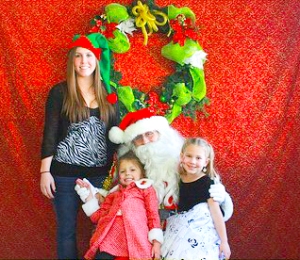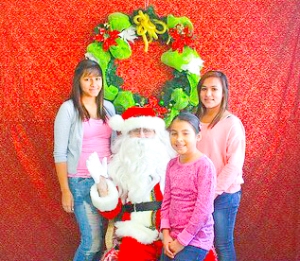In 1993, I was Santa Claus at the stylish Westside Pavilion in West Los Angeles, and the Los Angeles Times asked me to write a series of articles on the experience. From the outset, it was a hit. To read the text, skip below the photograph.
“Have you been good this year?”
That’s the question I ask children about 400 times a day at the Westside Pavilion. The question itself is a hallowed tradition.
“Yes,” answered Sadler, 7 3/4. “I helped Haley get away from Alex and Johnny. They were running after her and tackling her to the ground. Haley’s my best friend. I helped her to run away.”
“What did you do this year that was good?” is my frequent followup question.
Lots of kids are stumped at this one, and have to be helped to an answer. Other kids answer, “Play.”
Five-year-old Andre’s answer turned the question on its head: “I didn’t hit anybody.”
Derek, 6, answered like Ronald Reagan on Iran-Contra: “Too many things, I can’t remember.”
Sam, 4, answered existentially: “I was around. Every day.”
With one particularly verbal and confident child, Julian, I was more persistent than usual with my question.
“Have you been good this year?” I asked.
“Yes,” said Julian, who is 5.
“How good have you been?”
“Real good.”
“How good is that?”
“Super good.”
“How super good?”
“Super duper good.”
“How good is that?”
“As good as…as good as you can be.”
“How good is that?”
“Good like…like…like you don’t do anything wrong.”
And then his mother added: “He has been really good.”
These days, being good means different things to different people. What Julian meant was that he’d been good as a person, according to Mitch Golant, a clinical psychologist in West Los Angeles and author of the book, Disciplining Your Preschooler and Feeling Good About It.
“Julian was able to separate his goodness as a human being from those minor, day-to-day mistakes that we all make,” Golant said. “When Julian said he was good, he was really talking about his self-esteem. And his Mom mirrored his goodness as a person. What you saw in Julian was the result of good parenting.”
Some parents use Santa’s good-bad shtick as behavior control.
“Be good or you won’t get anything from Santa,” some parents have said in my presence.
That, of course, makes Santa’s opinion of their behavior of the utmost importance.
“Don’t give her anything, she’s bad,” said Tommy, 6, of his sister Lynnette, 9.
“Shut up,” said Lynnette.
“She hits me.”
“He pinches me.”
“Shut up.”
“You shut up.”
What we’re doing with this whole Santa business, really, is teaching our children about values. But these days, many people have lost their beliefs in rigid absolutes. After all, who can believe in traditional goodness after witnessing the behavior of all kinds of political leaders of the hypocrisy of the Bakkers or the Swaggarts, or hearing the long list of allegations against Woody Allen and Michael Jackson? It can all make one cynical.
One Santa Claus I know has become a bit cynical about his role as a shameless pusher of good thoughts and deeds. Bill Perron, 53, of El Monte, has been performing as Santa Claus for eight years now for a family in Covina.
One year, the family wanted Perron to call up 5-year-old Joey to help correct a behavior problem. Perron agreed.
“Hello Joey!” Perron said over the phone.
“Yes?”
“This is Santa Claus.”
“Hi, Santa Claus.”
“Joey, your parents tell me that you’ve been pulling your sister’s hair lately.”
Joey paused.
“Yes,” he reluctantly answered.
“Well, listen to me carefully, all right?”
“Okay.”
“You can keep pulling your sister’s hair,” Perron said. “Just don’t do it while your mother’s around.”
When I was a teenager, being good was very important to me. I rebelled against my parents not by taking drugs and telling my Dad where to get off, but by becoming a radical born-again Christian. I wanted to be holier–more good–than my parents.
And as a religious radical, being good took on what I now consider a rather sinister meaning. Being good meant not dancing, because dancing was sinfully sensual. Being good meant asking strangers about their conception of God, and then telling them that they were going to hell unless they converted to my conception of God. Being good, according to my Jesus, meant setting “a man against his father, a daughter against her mother, a son’s wife against her mother-in-law.” (Matthew 10:35)
In the intervening years, I’ve considerably softened my radical ideas. Today, my definition of goodness is best expressed by my friend Nancy Berg’s bumper sticker: “Practice random acts of kindness and senseless acts of beauty.”
Practice is right. If you practice anything–that is, do something over and over again–you’ll get better at it. Then, when the opportunity comes for performing a major act of kindness, one that requires a lot more courage, you’ll already know how to do it well.
And that’s one of the great things about being Santa Claus. The job has offered me countless opportunities for little kindnesses. Opportunities for being good.
An opportunity came last week with Addison, 6.
“I have a problem,” Addison told me.
“Yes?”
“I know that my Mom brings out the presents.”
I looked into his eyes–the saddest eyes I’d seen all season. I took his hand and began to explain about the spirit of Christmas.
“When kids are really little, like two or three,” I said, “they can’t understand about complicated things like love and giving. So we tell them it’s Santa Claus. They can understand Santa Claus. But when they get to be your age, you begin to understand that it’s just your Mom and Dad, because you’re smarter at age six.
“You see, nobody’s trying to lie to you. We just explain to the kids what the kids can understand.”
Addison’s mood didn’t undergo a major transformation, but it did seem to settle a bit. I’m pretty sure I helped him.
As Santa Claus, though, the good that you can do often remains unknowable. You see brief moments in a child’s life–usually two minutes at the most–and then the child walks away from your chair, usually gone from your life forever.
Earlier this month, though, I got a chance glimpse at some of the good I had done. I had been hired as a magician-Santa Claus for the holiday party at Truck Air Corp. in Compton. There were about 25 children at the party, including 4-year-old Kristina, who became especially attached to me. Kristina wanted to help with everything, was very chatty, and followed me wherever I went.
After the show, I ducked into a locking restroom and changed into my street clothes. When I came out, I was surprised to find Kristina waiting for me.
“Where’s Santa Claus?” Kristina asked.
“Oh, he left,” I said. “I’m helping with his stuff.”
I quickly wheeled out my dolly, left the building, and headed towards my car. As I was loading my boxes of Santa paraphernalia into the car, I heard a child call out.
“Santa!”
I looked back and saw little Kristina standing outside Truck Air’s front door.
“Santa! Where did you go, Santa?” Kristina called into the darkness, walking back and forth in the cold night air. “Where are you, Santa Claus?”
If you’re Santa Claus and someone is that sad when you leave, you can rest assured: You’ve been good. You’ve been very good.










Santa is our favorite visitor, except maybe for the grandparents!
Drives my son nuts that anytime I see a Santa I want us both to sit with him and get a pic… He’s now 15 and I’m, well, you’re never too old in my opinion! I’ve alway been honest about Santa to my son, like you said above, how he is the representation of holiday spirit and a physical reminder to be good all year, help others and spread cheer!
Great post!
Thanks for the kind words. Please share.
Woke up and read this today and just wanted to say I thought it was amazing! Great job
Thanks for the kind words. Please share.
Santa Claus has a place in our lives, children and grown-ups.
A place close to our hearts.
We forgot to tell you that Alix & Roxane from “Tails from Paris” have nominated your blog for the Liebster & the Super Sweet Blogging Awards :
http://tailsfromparis.com/2013/11/09/the-liebster-award/
You can choose either one or both. Because you’re worth it 😉
Have a super sweet coming week !
Alix & Roxane
Thank you so much.
Our pleasure 😉